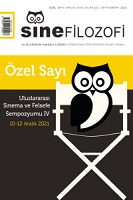Çavuşesku’nun Hayaletiyle Hesaplaşmak veya Romanya Yeni Dalga Sinemasında Bir Hatırlama Girişimi: Amintiri din Epoca de Aur
Reckoning To Ceausescu’s Ghost Or A Remembering Attempt In Romanian New Wave Cinema: Amintiri din Epoca de Aur
Author(s): Mehmet AytekinSubject(s): Social history, Sociology of the arts, business, education, Film / Cinema / Cinematography, Sociology of Art, Politics of History/Memory, History of Art
Published by: Serdar Öztürk
Keywords: Collective Memory; Remembering; Trauma; Romanian New Wave Cinema; Nicolae Ceauşescu;
Summary/Abstract: Memory and cinema are in a cooperation that feeds or shapes each other. Cinema processes recollections of individual or collective memory, while memory diversifies cinematic narrative. This unity also comes to mind in articulation of the events that societies or communities go through. It is thought that cinema plays an active role in narrativizing a data or trauma that needs to be remembered about memory sharing it by groups who have experienced similar things. Romanian New Wave Cinema, due to its structure, benefits from the traumas of Nicole Ceausescu’s period, one of the actors the Iron Curtain. It is known that individual and collective traumas leave serious traces in the memory of Romanian citizens, and it is thought that what is essential in many films under the umbrella of Romanian New Wave Cinema is to portray the need for the existence of a necessary ground for confrontation and reckoning. It is noteworthy that in this period, in which cinematic narrative examples are frequently utilized, the great oppression of the citizens caused traumas in individuals and communities, and these traumas were reproduced until the regime was changed/ collapsed. This study takes the first four episodes that first part of the movie Amintiri din Epoca de Aur (Tales from the Golden Age, Hanno Höfer et al., 2009), which is a representation of Romanian New Wave Cinema as an example and discusses the concept of collective memory through these four chapters that convey the negativities of Ceausescu’s era through black humor. For this, the discourses of Maurice Halbwachs on collective memory are used and episodes are read within this framework. Based on a holistic approach, it is aimed to support the proposition that although memory is thought to have an individual quality, the group in which the individual belongs are more dominant over memory.
Journal: SineFilozofi
- Issue Year: 7/2022
- Issue No: Sp. Iss.
- Page Range: 300-330
- Page Count: 31
- Language: Turkish

